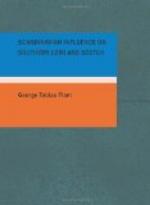4. Consonantal assimilation of nk
to kk, mb to bb, mp to
pp, ethl to ll, zd
and rd to dd, corresponding to
similar assimilation in Scand.
5. Other consonantal and inflexional
forms that are Scand., as
opposed to O. Nhb. d for Scand.
d, O.E. eth excluded, see Sec.Sec.19
and 23.
6. A word that is used in a sense
distinctively Scand., as opposed
to Eng. or L.G., is to be regarded as
a loanword.
7. The distribution of a word in
South England diall., or in O.F.,
O.S. or M.L.G., indicates that the word
is not a Scand. loanword.
8. On the other hand, if a word occurs
exclusively in Scand.
settlements in England and Scotland, it
is to be regarded as due
to Scand. influence in Scotch in spite
of L.G. parallels.
9. The presence of a word in O.E.
excludes Scand. influence,
except in cases where the O.E. word has
been shown to be a
loanword. See Steenstrup and Kluge.
25. REMARKS ON THE TEXTS.
The following dates it may be well to remember:
Barbour’s “Bruce” finished
about 1375.
Wyntoun’s Chronicle written about
1420.
Henry the Minstrel’s “Wallace”
written about 1450.
Dunbar lived from 1460 to 1520.
Douglas lived from 1475 to 1520.
Sir David Lyndsay lived from 1490 to 1555.
Alexander Scott lived from 1547 to 1584.
“The Complaynt of Scotland”
was written about 1549.
Alexander Montgomery lived from 1540 to
1610.
Allan Ramsay lived from 1686 to 1758.
Robert Burns lived from 1759 to 1796.
“The Bruce,” Wyntoun’s “Cronykale” and the “Wallace” belong, then, to the early period of Scotch, which, for convenience, has been called Old Scotch. The last half of the 15th Century is a transition period. The language of Dunbar and Douglas is already Middle Scotch. Middle Scotch of the 16th Century is further represented by Lyndsay, Alexander Scott and Montgomery. “The Complaynt of Scotland” is Central Scotch of the middle of the 16th Century. Ramsay represents Early New Scotch. The language of Burns is in all essentials present Scotch. From the Scottish War of Independence down to the Union of the Crowns the literary standard of Scotland was Central Scotch. After the Union there was no longer a Scotch language of literature and Central Scotch became a mere spoken dialect like the other dialects of Scotland. The writings of Ramsay and Burns represent local dialects just as the large number of Scotch dialect writers of the last and this century have written in their own peculiar local vernacular. The great majority of loanwords are taken from “The Bruce,” “The Wallace,” Douglas, Dunbar, Scott and Montgomery. “The Bruce” has a large number of Scand. elements; it represents, however, literary Scotch and not Aberdeen Scotch of 1375.




